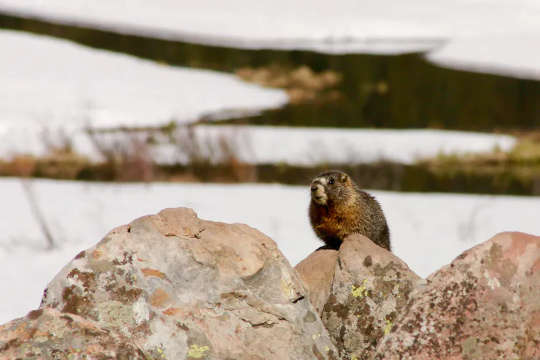 Meerkats on high alert. Ronnie MacDonald/Flickr, CC BY-SA
Meerkats on high alert. Ronnie MacDonald/Flickr, CC BY-SA
Even with fires, droughts and floods regularly in the news, it’s difficult to comprehend the human toll of the climate crisis. It’s harder still to understand what a warming world will mean for all the other species we share it with. This is true for even our closest relatives in the animal kingdom – the mammals. From mice to elephants, mammals are being affected by rising global temperatures in positive and negative ways that are hard to keep track of.
Take Svalbard reindeer. In their wintry habitats, rain falling on snow creates impenetrable ice sheets that envelop the vegetation that the reindeer eat. Conditions like these are only set to become more common in the changing climate.
You’d expect this to spell trouble for the species, but a recent study showed that climate change might actually stabilise reindeer populations. Why? Because more rain on snow is likely to cull young or elderly reindeer, easing competition within a reduced population to the benefit of more resilient age groups
 Reindeer may be more resilient to climate change than first impressions suggest. Ginger_polina_bublik/Shutterstock
Reindeer may be more resilient to climate change than first impressions suggest. Ginger_polina_bublik/Shutterstock
Let’s consider another case: the meerkat. This African dryland specialist is adapted to withstand severe seasonal droughts, so hotter seasons shouldn’t really be an issue. But timing is important. When warmer weather combines with more unpredictable rainfall just before breeding season begins, it can reduce fertility and raise the risk of extinction for some meerkat populations.
We know that the effects of climate change are complex. Yet, in new research supported by the iDiv, the German Center for Biodiversity, our international group of researchers set out to assess whether biodiversity studies – particularly those in regions experiencing the biggest changes in weather – actually examined the impacts of climate change on mammal populations. As it turns out, many of them didn’t.
Understanding climate change with mammals
Our study found that climate affects mammal populations in both positive and negative ways, depending on the lifecycle stage of an animal – whether a cub, juvenile, or adult – or their interactions with other species around them.
In the case of impala – a species particularly vulnerable to increasing drought – less rainfall doesn’t necessarily harm their chances of survival or reproduction. Like the Svalbard reindeer, the effects of climate change tend to only bite when populations are especially dense.
Understanding these complex interactions is deeply important. Impala and reindeer, like many mammals, are not just a food source for humans: their eating habits also control plant populations, which in turn provide clean water, healthy soil and nourishment for other species in the food web. It’s in our interest to understand how mammals react to climate change, to learn how we – and the wider environment – might fare.
There’s a lot of work to be done. So far, researchers have only assessed the climate’s often contradictory effects on 87 mammal species – about 1% of the known 6,400 mammal species worldwide. Worse, we know very little about these complex potential effects in parts of the world most likely to see the biggest changes in temperature and precipitation, such as the Arctic.
Unlocking survival secrets
Human influences on the environment also tend to make the changing climate’s effects worse. In regions with lots of species, like the tropics, the destruction of habitat by people has combined with more unpredictable weather to cause particular harm to mammals.
Lemurs in Madagascar, already threatened by deforestation, are now facing drier weather – adding food scarcity to an already long list of threats. But without data tracking how species are responding at different stages of their lives in these regions, it’s difficult to predict what might happen next.
To effectively predict the fate of mammals, scientists need data collected from studying individual animals at many sites and across many years. This can tell us about their chances of survival and reproduction.
More than four decades tracking one North American mammal, the yellow-bellied marmot, has given scientists an incredibly detailed understanding of how species may actually adapt to climate change. As growing seasons have lengthened, there are more alpine plants for marmots to eat throughout the year. These ground squirrels have responded by staying active for longer and gorging, steadily increasing their body mass as a result. Following individual animals across thousands of acres and decades can unveil how our closest relatives are learning to adapt to a changing world.
 A one-year-old yellow-bellied marmot. Dr Arpat Ozgul, Author provided
A one-year-old yellow-bellied marmot. Dr Arpat Ozgul, Author provided
Out of all the types of animal on the planet, the furry and cuddly charms of mammals win them disproportionate scientific attention. If our climate-related data on mammals is nonetheless this scarce, then our lack of knowledge on how climate change affects other, less charismatic groups of species, like insects or amphibians – who are highly vulnerable to climate-driven extinction – should sound alarm bells.![]()
About The Authors
Maria Paniw, Research Fellow in Conservation Biology and Global Change, Estación Biológica de Doñana (EBD-CSIC) and Rob Salguero-Gómez, Associate Professor of Ecology, University of Oxford
Related Books
Life After Carbon: The Next Global Transformation of Cities
by Peter Plastrik , John Cleveland The future of our cities is not what it used to be. The modern-city model that took hold globally in the twentieth century has outlived its usefulness. It cannot solve the problems it helped to create—especially global warming. Fortunately, a new model for urban development is emerging in cities to aggressively tackle the realities of climate change. It transforms the way cities design and use physical space, generate economic wealth, consume and dispose of resources, exploit and sustain the natural ecosystems, and prepare for the future. Available On Amazon
The future of our cities is not what it used to be. The modern-city model that took hold globally in the twentieth century has outlived its usefulness. It cannot solve the problems it helped to create—especially global warming. Fortunately, a new model for urban development is emerging in cities to aggressively tackle the realities of climate change. It transforms the way cities design and use physical space, generate economic wealth, consume and dispose of resources, exploit and sustain the natural ecosystems, and prepare for the future. Available On Amazon
The Sixth Extinction: An Unnatural History
by Elizabeth Kolbert Over the last half-billion years, there have been Five mass extinctions, when the diversity of life on earth suddenly and dramatically contracted. Scientists around the world are currently monitoring the sixth extinction, predicted to be the most devastating extinction event since the asteroid impact that wiped out the dinosaurs. This time around, the cataclysm is us. In prose that is at once frank, entertaining, and deeply informed, New Yorker writer Elizabeth Kolbert tells us why and how human beings have altered life on the planet in a way no species has before. Interweaving research in half a dozen disciplines, descriptions of the fascinating species that have already been lost, and the history of extinction as a concept, Kolbert provides a moving and comprehensive account of the disappearances occurring before our very eyes. She shows that the sixth extinction is likely to be mankind's most lasting legacy, compelling us to rethink the fundamental question of what it means to be human. Available On Amazon
Over the last half-billion years, there have been Five mass extinctions, when the diversity of life on earth suddenly and dramatically contracted. Scientists around the world are currently monitoring the sixth extinction, predicted to be the most devastating extinction event since the asteroid impact that wiped out the dinosaurs. This time around, the cataclysm is us. In prose that is at once frank, entertaining, and deeply informed, New Yorker writer Elizabeth Kolbert tells us why and how human beings have altered life on the planet in a way no species has before. Interweaving research in half a dozen disciplines, descriptions of the fascinating species that have already been lost, and the history of extinction as a concept, Kolbert provides a moving and comprehensive account of the disappearances occurring before our very eyes. She shows that the sixth extinction is likely to be mankind's most lasting legacy, compelling us to rethink the fundamental question of what it means to be human. Available On Amazon
Climate Wars: The Fight for Survival as the World Overheats
by Gwynne Dyer Waves of climate refugees. Dozens of failed states. All-out war. From one of the world’s great geopolitical analysts comes a terrifying glimpse of the strategic realities of the near future, when climate change drives the world’s powers towards the cut-throat politics of survival. Prescient and unflinching, Climate Wars will be one of the most important books of the coming years. Read it and find out what we’re heading for. Available On Amazon
Waves of climate refugees. Dozens of failed states. All-out war. From one of the world’s great geopolitical analysts comes a terrifying glimpse of the strategic realities of the near future, when climate change drives the world’s powers towards the cut-throat politics of survival. Prescient and unflinching, Climate Wars will be one of the most important books of the coming years. Read it and find out what we’re heading for. Available On Amazon
From The Publisher:
Purchases on Amazon go to defray the cost of bringing you InnerSelf.comelf.com, MightyNatural.com, and ClimateImpactNews.com at no cost and without advertisers that track your browsing habits. Even if you click on a link but don't buy these selected products, anything else you buy in that same visit on Amazon pays us a small commission. There is no additional cost to you, so please contribute to the effort. You can also use this link to use to Amazon at any time so you can help support our efforts.
This article is republished from The Conversation under a Creative Commons license. Read the original article.























